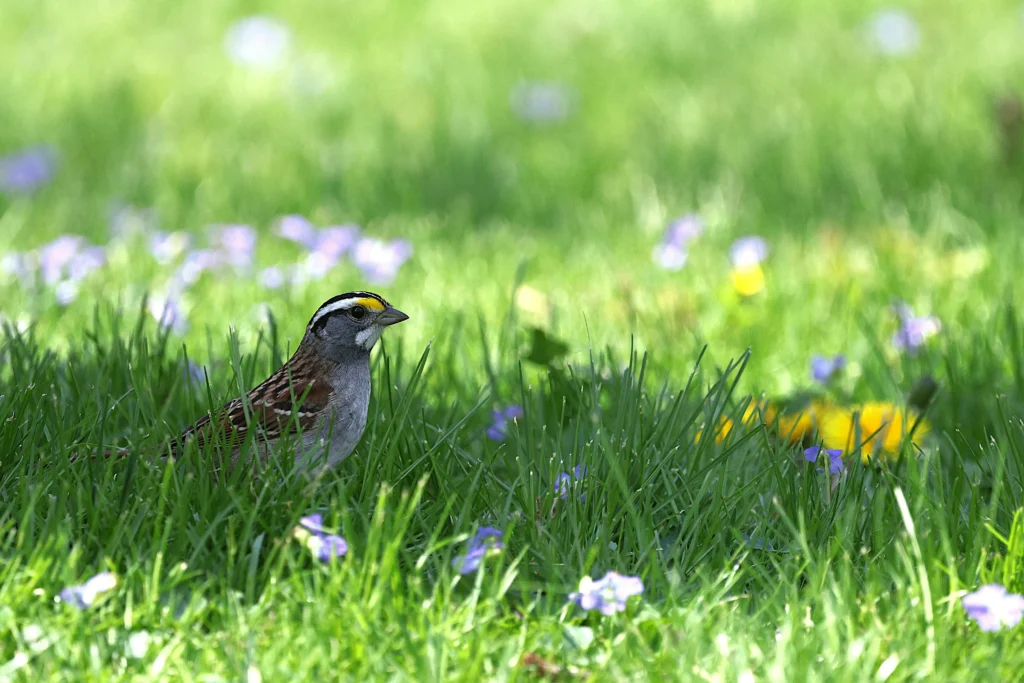Loving green grass is a common sentiment. It’s lush and alive, smells good, invites whiffle ball games, allows one to lie back and stare at the clouds floating by in the sky… or the stars at night.
Green lawns are often appreciated for their aesthetic and recreational value. They provide a visually appealing landscape, offer comfortable surfaces for outdoor activities, and contribute to community green space. In addition to their cultural and recreational appeal, lawns offer several ecological benefits.

Grasses on slopes help prevent soil erosion, while roadside turf can intercept rainwater runoff. Grass root systems play a role in filtering stormwater contaminants, including those originating from roads, thereby protecting nearby vegetation and aquatic ecosystems. Turf systems also create an interconnected soil structure that supports a range of organisms, including insects, fungi, and microbes.
Lawns, particularly those not treated with herbicides or pesticides, can support biodiversity. A small section of untreated turf may contain numerous species of grasses and broadleaf plants. Common examples include Kentucky bluegrass, ryegrass, clover, dandelion, yarrow, wild carrot, and plantain, among many others. This diversity contributes to a complex habitat that supports insects, birds, and small mammals, which play vital roles in nutrient cycling and food webs.
Furthermore, lawns can provide early-season forage for pollinators. Delaying mowing until late spring allows early-blooming plants such as dandelions to support emerging bees. Lawns also serve as cool, shaded areas during warmer months, and tall, dense turf can reduce soil moisture loss and improve drought resilience.
Despite these benefits, conventional lawn maintenance practices pose environmental concerns. Emissions from gasoline-powered lawn mowers contribute to air pollution. Battery-powered electric mowers provide a lower-emission alternative and are increasingly accessible, though they may have limitations in dense or overgrown areas. Managing mowing frequency and turf height can also help mitigate heat stress on grasses and reduce the need for supplemental irrigation.
Perhaps the most common concern about modern lawn care is the use of chemical fertilizers, herbicides, and pesticides. While fertilizers can promote rapid turf growth, they are often unnecessary if grass clippings are left in place to decompose naturally. Even organic fertilizers, when overused, can contribute to nutrient runoff, which leads to downstream ecological issues such as algal blooms, eutrophication, and fish mortality. Additionally, the industrial production of synthetic fertilizers has a complex history and a considerable negative environmental footprint.
A perfect-looking lawn, but at what cost? Credit: Pexels.com.

Some herbicides and pesticides commonly applied to residential lawns present ecological and human health risks. These chemicals can contaminate surface water, harm non-target organisms (including beneficial insects and pollinators), and have been linked to chronic illnesses in humans. The widespread application of these substances has been shown to contribute to environmental degradation and to pose potential risks to pets, children, and wildlife.
Chemical-based tick and mosquito control also raises concerns. Broad-spectrum insecticide applications can negatively impact beneficial species such as bats, birds, and aquatic organisms that rely on insects as a food source. Alternatives such as integrated pest management and personal protection strategies can be sustainable and effective over the long term.
Other options homeowners and land managers use to reduce the environmental impact of lawn care include converting sections of lawn into native meadows, installing vegetable gardens, composting organic waste for natural fertilization, and increasing planting density to suppress invasive species. These practices promote biodiversity, conserve water, and reduce the use of chemical inputs. Selecting native plant species ensures greater ecological compatibility and resilience.
Lawns remain a prominent feature of residential and public landscapes, upholding the widely held aesthetic ideal. By adopting more sustainable approaches — such as reduced mowing, chemical-free maintenance, and the integration of native plantings — lawns can continue to provide enjoyment while serving as valuable ecosystems that support both biodiversity and environmental health.
Bettina Abe is a retired Acton Natural Resources Assistant. She is a member of the Land Stewardship Committee, Open Space Committee, and Friends of the Acton Arboretum, Inc.













